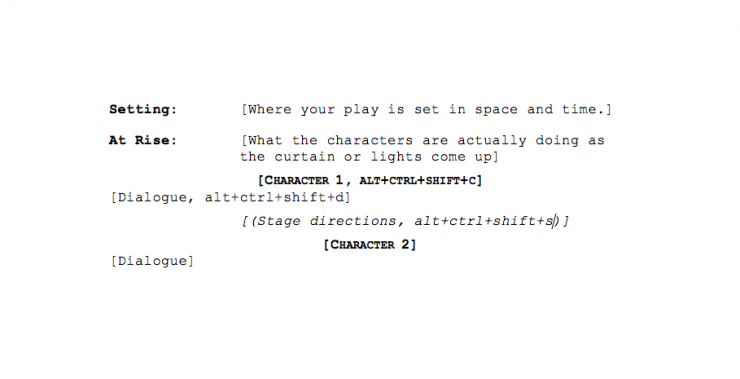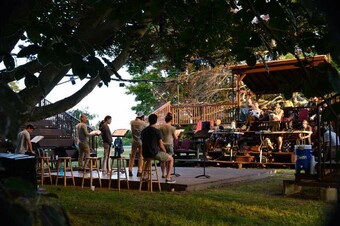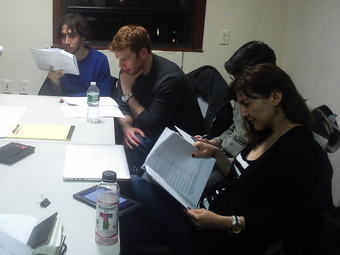Shaping the Conversation
Script Formatting and Twitter
My attempt to co-moderate a HowlRound discussion on Twitter, Howlround’s elected conversational platform proved an interesting exercise in view of my topic, which was the effects of script formatting within the theatre industry, while providing ready examples to illustrate the crippling effects of standard script formatting on playwrights. Yet, despite the challenges, a conversation grew in response to my initial prompt, along with contributions from co-moderator HowlRound, into a needed discussion about how we as theatre practitioners define the script’s functions within the theatre and how script formatting impacts our work.
It began with my invitation on Facebook. Twitter doesn’t accommodate paragraphs, or even complex sentences.
Generally, I’m interested in discussing the event of the play on the page, and the continued solicitation of standard play formatting by organizations that solicit new and innovative works. Considering the capacities of theatre for spatial play, does the adherence to linearity formatting like Final Draft, which is modeled on industry standards limit more than just playwriting poetics/innovation? What are the broader implications in terms of our ability to contribute new ideas, and to our craft?
Of course, I chopped all of my thoughts into bits in advance, so I would be prepared to express my questions and views in the correct character count for Twitter.
The conversation hovered on the topic of how the script functions, which was more revealing of some basic questions that need to be addressed within the industry. I hesitate to ever use the word “industry” to describe the space of theatremaking, but the fact is, there continues to be top-down influence on us as theatre practitioners, who are traditionally slow to absorb new ideas, and continue to comply with industry standards rather than refuse or challenge them. Polly Carl said it best in her article Docile Bodies; Disciplining the Imagination, in which she decries the docility of artists through conformity to a discipline.
Although my work falls outside the bounds of what most theatres produce, I’m curious nonetheless how the lack of discussion about the submission process as it relates to formatting may be leaving us all in the dark about what forms of work are actually being created and submitted and rejected. I’m also concerned that as specific forms are elicited, conformity through the use of templates such as the scriptwriting template produced by Final Draft is hindering innovation. The fact is most producers these days don’t even want theatre with the characteristics that Final Draft or other formatting software is equipped to generate. What really motivates my efforts here is the fact that there are plenty of theatre artists who develop unique formats for notating their works; the form is the content. That is the work. The industry standards are simply nonrepresentative of what’s happening, yet the practice is taken for granted, and the format elicited.
What really motivates my efforts here is the fact that there are plenty of theatre artists who develop unique formats for notating their works; the form is the content. That is the work.

It turns out I am not alone in my concerns about conformity to submissions requirements, as revealed by a discussion defining the functions of a script to the production, as opposed to its expressive functions for the playwright’s individual poetics. HowlRound responders contributed numerous examples of works written in alternative formats and also aired views on the benefits of expanding the limitations of formatting, and even fantasized a bit about what might emerge in submissions processes that were more open.
As a novice to Twitter, I was struggling to express thoughts within a reasonable time in the abbreviated format proscribed. I attempted to track the respondents all over the proverbial map, and to follow conversations that varied from mechanical questions about which font is preferred by literary managers, and other specific queries about submissions requirements, to insightful inquiries on topic. I fared much better once I accepted my failure to moderate, or at least to moderate in the traditional sense, because of the linear structure of the live-streamed chat that quickly progresses down the page, and disappears from view. The linearity also made it impossible for me as a novice to distinguish one tweet from another. Without some application that aggregates the individual voices into a visual format with spatial attributes, there is little way of forming a picture of the landscape of varied views and voices. Without sensory cues customary in a face-to-face or phone conversation—the sound of the voice—I was lost. I began to fire off my munitions of phrases prepared within the word limit, without much hope of connecting in conversation, before deciding this is the new form of moderating. I’ve preserved the shape of the original conversation, as follows, and expanded a bit on my interests that inspired me to initiate discussion:
@Lisleaverton Does the use of formatting programs like Final Draft limit more than just playwriting poetics?
@Lisleaverton What are the broader implications in terms of our ability to contribute new ideas, and to our craft? #newplay
@Lisleaverton I am most concerned with how our lack of attention to the event on the page affects the craft of playwriting. #newplay
My questions were largely met with silence, but I reminded myself that people were busy condensing their thoughts into 140-character chunks. They were editing. Fortunately, the veteran (anonymous) blogger for HowlRound obviously understood the necessity of repeating, abbreviating, and retweeting in the interim.
@howlround: Writers, ‘turgs, producers—How do script formats impact our art, production?
@lisleaverton: Generally, I’m interested in discussing the event of the play on the page.
@howlround: Where did the industry-standard formatting of scripts come from? What are the benefits for theatres that solicit scripts?
Howlround’s questions continued to bob.
@howlround: Playwrights, 'turgs: what qualities of the theatrical experience are standard script formats good at expressing?
Finally, after a few splashes, a cannonball, on topic!
@jfdubiner: Very little beyond dialogue.
Now the tweets began to come, fast and furious. And the voices were certainly diverse. One commentator expressed the view that format is irrelevant:
@dLoehr: You can describe as much or as little as you want in any format
The useful word here, in our discussion is describe. This HowlRound responder went on to talk about his formatting of poetry, in a play about poetry. He didn’t see why the template would be limiting and claimed “descriptive powers are all we need.” And in fact, Final Draft works well for description and linear dialogue, so this probably would work well for him, considering the particular project he described.
Some splashes of conversation, as responders considered just what standard format can and cannot do.
@cmeak: how are we defining “standard” format? 3 playwrights use 3 diff fonts, styles, spacing, etc. Writing is still good.
Aside from how we as playwrights may define ourselves, sadly, there is a standard that still prevails to a great extent within the industry. Even many organizations soliciting “innovative” work demand standard formatting. The format is more reminiscent of publishing standards and screenwriting than anything related to the wide variety of playwriting poetics. Fortunately, the conversation organically progressed in this direction thanks to several provocative transmissions from co-moderator HowlRound:
@howlround: What are alternatives for playwrights to communicate a platform for "theatre event" besides the standard?
@howlround: What limitations in depicting the theatrical experience do you feel the standard script format makes?
@howlround: Do you feel that the standard format is the best format for the theatre you want to make?
As I continually struggled to express myself in this constrained format, I couldn’t help but comment about the limitations of communicating with 140 characters. “Brevity” hardly describes the task of condensing complex thoughts requiring multiple sentences into tweets. What was billed as a “chat” seemed a lot more like people transmitting intriguing bits, interesting in view of my frustration with the theatre industry’s continued reliance upon inappropriate standards. I should say of course, that there are theatres for which standard script formatting probably makes sense because it matches their aesthetic sensibilities! I should also say that I am aware that it is possible to produce innovative work using Final Draft. It’s just the lack of awareness and openness about formatting choices that proves disastrous. Another commentator responded to remind us of what exactly standard script formatting actually does best:
@cmeak: “standard” as in some prose description, character dialogue, character dialogue…similar to the movie industry format
One of the dramaturgs acknowledged that the old standard still in use was geared (originally) to ease the physical handling of scripts.
@jfdubiner: we are beyond this, technologically, and that although dramaturges can handle scripts in alternative formats, production cannot.
In a later tweet she reminded us of the actual function of the formatting to the lit office:
@jfdubiner: More different is there are fewer physical files to file. We don't need to be stuck in 8x11, silent, no pix world.
This was an important point in light of my own argument, or the one in my mind, about how the standards generally serve the production but not the playwright. Not to mention, with digital media, the physical considerations involved in standard script submissions are obsolete. Scripts needn’t all be the same size to be stacked when they were no longer stored on a shelf.
In her next tweet, @jfdubiner seemed to imply that there is a need for a script (or a communication procedure) that serves a central function to the production, but I wasn’t certain if that is what she was saying, based on her truncated Twitter communication:
@jfdubiner: The amt of formatting so that people can be actually on same page in production is exhausting and damaging
@bloodinthestone: do any lit folks reject newplay scripts because they aren’t in “standard format”?
Howlround fired off a relevant question:
@howlround: For theatres that solicit scripts—which scripts make it to the top? Can you describe if there's a certain aesthetic similarity?
@jfdubiner: I’ve never worked anywhere that had specific font/format rules. Should be readable. Beyond that, whatever
@emphaticstate replied: So the change in format is something you find is more of a move to digital scripts as opposed to physical ones? Exciting
I fired out one of my prepared phrases, excited by the acknowledgment of new forms that surely merited more openness in terms of formatting requirements:
@lisleaverton: Visual artists invent formats. Musicians create notation systems. Cartography has been reinvented.
I wanted Howlers to think about the greater cultural implications relating to the use of outdated standard script formatting in view of the huge cultural upheaval we are experiencing at a time when we are seeking new ways of seeing that are nonlinear and nondualistic, and our search for new forms that help us connect with the environment and challenge existing taxonomies kept in place through their representation, along with our conception of time and space. Our works’ visual or textual format is revealing of our ecological visions and relations. But this conversation stalled in my imagination while the HowlRound conversation grew yet more focused on defining the relationship between industry and artist, and the function of formatting as a communication between, which was probably more useful to revealing the obsolescence of standard formatting than anything I could have brought to the discussion. One of the HowlRound responders expressed similar views about the greater implications of limiting writers through outdated requirements.
@emphaticstate: I worry that using a standard makes my plots biased towards being character-driven as opposed to other possibilities.
This raised the important issue of the limits to which playwrights are subject by the continued imposition of outdated standards. Although I do not personally submit work to theatres making such demands, I am concerned about the state of theatre and its slowness to adapt to current cultural reality. Another howler expressed a similar point of view.
@dbknifeandfork: Standard format is not how I choose to work. Our work is devised. I work in outlines, with plot “anchors.”
@emphaticstate responded: Hear, hear! More options often = more opportunities for community at large.
@melissaimpact enumerated the typical concerns of the lit office in her tweet:
Quality of writing, ability to produce in our idiosyncratic space, roles for my resident actors, affordability/tech reqs…and then the aesthetic issues, like does this speak to a Bay Area under-40 aud (our base)? Finally, mission-related issue: Is it published? (we only do unpublished)
HowlRound steered course.
@howlround: If you're a theatremaker who doesn't submit scripts in hopes of getting produced by others: Do you still use standard format?
Another responder piped in with an important point about the positive changes that arise when writers actually allow poetics to have their place, a question that hadn’t yet surfaced in a conversation largely centered around what formatting is and its use in production:
@sballema: I appreciate when writers use blank space to help communicate relative time between word/events/images.
The conversation moved toward aesthetic concerns with several tweets from @mariselaTOrta, probably the most adept Twitter conversant I have ever encountered in my brief life as a Twitterer:
@mariselaTOrta: In poetry you send yr poem out into the world w/the understanding that you won’t be there to explain it to people who read it & (1) knowing that readers are co-creators bringing their own framework to help them experience the poem. So you do your best (2) using line breaks, word choice, rhythm, space on the page to put onto paper the experience you hope to evoke (3) in the mind of the reader. I approach playwriting in the same manner. (4)
Our Final Draft user had been quiet for awhile, but he piped in here:
@dloehr: For shows we produce at my company, I generally use TV format, actually. More white space for notes.
This illustrates the big division in the industry at the moment; the gulf between these posts begged the question about our disciplinary divisions, so I fired off:
@lisleaverton: Wow, some questions here. Why the division between poets and playwrights?
@mariselaTOrta: What division?
In a rare moment of experiencing a “conversational” sensation, of colliding midst the sea of bobbing tweets, I connected with two people, singling their voices out of the sea of undifferentiated communications.
@emphaticstate Agreed; I write both and consider them to be fairly fluent forms that melt into each other regularly.
@lisleaverton: Do standard scripts allow for poetics? Thoughts?
@howlround: If you're a “freelance” theatremaker hoping to get produced by a theatre, do you feel pressured to conform to the script format?
@MariselaTOrta: I find they do. Lyricism/word choice, rhythm in dialogue, space for pacing, imagery in the stage directions...
The conversation addressed the need for discussion about the divided role a script plays, on one hand a venue for the poetics on the page for a playwright, and on the other, the explication device for a production. Even if I hadn’t successfully moderated the conversation, it got there without me.
@howlround nudged a bit, since it was clear that many respondents favored more openness with regards to submissions requirements that are more representative of the work being created.
@howlround: How equipped are “literary” departments for engaging in plans for a work that doesn't fit the standard format?
@MariselaTOrta directed a question to @dbknifeandfork relating to the difficulties that might be encountered in producing devised works with formatting allowing for improvisation:
@MariselaTOrta: Not writing it down, does that mean this play will only be done once by your group & then never again?
I fired off to @MariselaTOrta:
@lisleaverton: If playwriting is a tool, our tools should evolve.
@MariselaTOrta: I don't think playwriting is our tool. It's what we do. Words are tools. Computers are tools. Tools 2 help express.
She disagreed with my statement that playwriting itself was a tool! That would have been a great topic over coffee! But I wouldn’t be able to go there. The tweets streamed down the page.
@lisleaverton: But what if we ourselves have to invent a new tool.
@MariselaTOrta: Playwriting is our craft.
I chafe upon use of the word “craft” since the terminology streamlines so perfectly with current ideas about production that predominate in the theatre and crowd out the event on the page. I could see that in the limited time, I would not be able to tweet about these philosophical issues, and to try to demonstrate how playwriting, as a tool for seeing and modeling action, also records a transforming world, as much as cartography, a discipline that has left the theatre discipline in the dust by its inclusion of alternative formats, such as GIS (Geographic mapping system) and other programs that allow data to be shaped. The amount of information we are expected to encounter daily would fly right past our awareness were it not for innovative design.
@melissaimpact declared: I have a hard time understanding why formatting is imp to any producer. Audience can’t see the formatting, so who cares?
Then, she took a moment to clarify: Are we talking about format (as in how the play occurs in the world) or formatting (how it occurs on the page)?
@dbknifeandfork raised a really important issue about the submissions process, pointing us to consider alternative processes theatres soliciting work might engage in the future.
@dbknifeandfork: Furthermore, what might a literary dep need to see to consider engaging in plans for a nonstandard work? press? video?
The practice by theatres of soliciting solely script in the submissions process is also unrepresentative of the variety of work being generated. For example, a piece of devised theatre viewed on video, supplementing the literary department’s reading of the script can make all the difference.
HowlRound clarified the conversation:
@howlround: Is there aesthetic bottlenecking, conformity inadvertently imposed on the field by theatres soliciting standard format scripts?
I appreciated this tweet that raised awareness of the process of literary offices, and the problems of educating interns as readers.
@halcyonytony: what does it teach the interns actually reading the scripts if evaluating a script is based on arbitrary format rules?
@dloehr responded: Odds are, theatres demanding a rigid format aren't looking to innovate anyway.
@lisleaverton: I disagree. Theatres are still demanding scripts in standard formatting, yet soliciting “innovative” works.
All in all, I was pleased that the topic was activated in the community, and I am hopeful that further discussion might be opened. Should there be initiatives for expanding theatre’s capacities as readers of scripts? What types of discussions do we need to have that open ways of evaluating how such practices can better serve our artistic and productive needs? What is it that makes us cling to a “discipline” at all costs, even at the cost of obsolescence? What makes us think we can express everything in one shape through time?











Comments
The article is just the start of the conversation—we want to know what you think about this subject, too! HowlRound is a space for knowledge-sharing, and we welcome spirited, thoughtful, and on-topic dialogue. Find our full comments policy here
Fascinating to read on all fronts. Maybe all formats are limiting? Maybe all formats fall short of capturing the intense sensation of story/event/character/experience that a writer is hoping to somehow share. Full disclosure: I use Final Draft -- but I change how it looks (and feels) on the page with every play I write (there are many ways to change things up in Final Draft). The formatting changes as the play evolves -- and I find that useful to my own process of invention. I suppose the danger with any kind of "boilerplate" is that it numbs the imagination and takes on a "fill in the blank" energy. Much the same way that "stage directions" can be personal and specific to the tone of a play, I find the same to be true with formatting. Until reading this interesting essay I haven't thought about "format" for a long time... I think about it more as "How can I organize my play to best represent how it feels to me as the writer?"
For some writers, I'm sure format is simply a container. For others it is part of the play itself.
Thanks for writing this essay and sharing the Tweet-conversation.
Was this written by Alan Sokal?
An interesting topic. I'd like to hear more from others on it than can be accomplished in a Twitter post [one reason I don't twitter, as it basically reduces conversation to 'sound bites' and our culture is already woefully addicted to that form of communication]. I was both intrigued and mystified by responses. Would like to see a longer post with examples of different formatting. Depending on the 'style' of the theatrical piece, I can see where creative options for format would be beneficial. However, as most theater that I see is still character / dialogue driven, I personally require more specifics to more fully and clearly appreciate and understand the 'charge' that this topic has for some individuals. One person wrote they don't use standard format [I vary from it somewhat and all my scripts I write in word then save as pdf] as their pieces are "devised" they "work with outlines" utilizing "plot anchors." This is an example where I would have appreciated more detail. Devised is a very general word, it conjures up for me something conceived that needs to be worked out and developed. Thus the outline? What is meant by "plot anchors?" It sounds to me like something that is very general, and not sufficiently complete to submit to theaters. Unless you're lucky enough to be associated with a theater that knows your work and is willingly seeking to work with developing "outlined pieces" then I'm not surprised a standard format would be limiting. But again my lack of possible sufficient specifics could be contributing to my interpretation.
Another person said something about alternatives to 8 1/2 x 11 paper. I'm not sure what that means. Do they have a preference for 11" x 14"? Does it really make that much of a difference?
Another person mentioned pacing, rhythm, silences etc that variations of formatting would be helpful for. I'm not arguing with this perspective [would have liked an example] but I also find that pacing and rhythm can be sufficiently indicated by usual punctuation options [ , ; - . . . ] and then there are always the useful possibilities of [a beat; a slight beat; a pause; a chilling silence etc etc] placed within the script.
Yes, I do find it probable that present day 'standard format' is a bit anal in what is accepted or not accepted. The font issue in my opinion is a bit ridiculous. But personally I have more important priorities on my play writing agenda than picking a bone with theaters about the font they want used for a script. It's challenging enough getting someone to read your script these days.